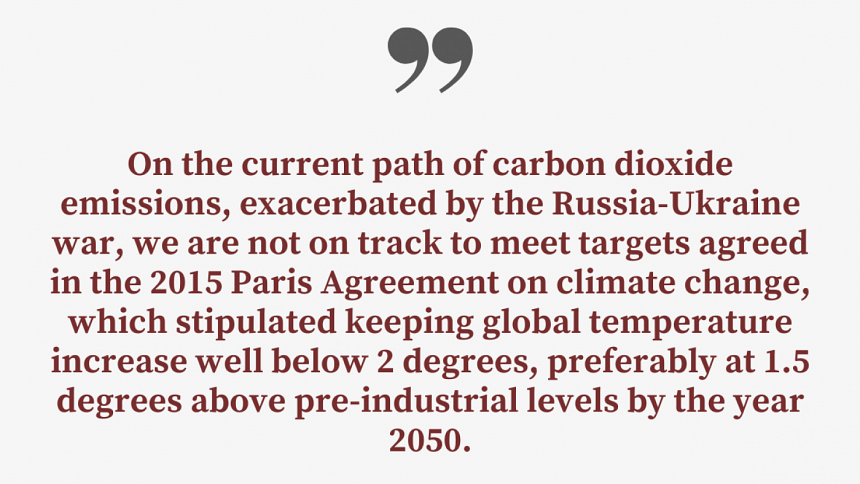Sizzling summer of 2022: Heat wave, heat dome, wet-bulb temperature

The summer of 2022 has not yet reached the mid-point, yet we are staring at another year of bleak climate news. In India, Pakistan and Bangladesh, summer began early this year with temperatures soaring upward from March. Pakistan already faced five successive heat waves, with Jacobabad registering a scorching 49.5 degrees Celsius at one point in May. A blistering heat wave is sweeping through northern India causing mercury to flirt with all-time high May temperature of 47.2 degrees in Delhi. The highest temperature of the season in Bangladesh was 42.2 degrees recorded in Rajshahi in mid-April.
As heat waves sweep across the northern hemisphere, particularly continental Europe, the UK, Indo-Pak subcontinent and parts of the United States, June 2022 saw the warmest temperatures on record for a specific month. And that was before summer officially began on June 21, raising concern among climate scientists that heat waves are arriving much earlier as the planet warms.
Moreover, over a three-day period (July 15-17), temperature in Greenland was high enough – 15.5 degrees – to melt 18 billion tons of the country's ice sheet, contributing to an increase in the global sea level. A loss of 6 billion tons of ice per day is alarming, especially since the effect of melting is cumulative. This confirms scientists' fear that the worst-felt impacts of heat waves will be in the Arctic.
While world leaders often focus on changes in average global temperature, they do not realise that our life does not revolve about the global average. According to climate scientists, land temperatures are more representative of the climate changes most people experience. Temperatures on land in June 2022 was around 1.8 degrees warmer since the late 1850s, with most of that warming occurring over the past few decades. Since the early 1980s, land temperatures in June have risen by more than 1.5 degrees.

Clearly, hotter, longer and more frequent heat waves are an unmistakable sign of climate change. Also, the heat waves that shattered records in North America in June 2021, leaving hundreds dead as temperatures soared to 50 degrees in places, would have been impossible without global warming. The current heat waves are forecast to become even more severe as the summer progresses, prompting concerns over infrastructure problems like melting of road surfaces, widespread power outages and warped train tracks, in addition to triggering wild fires, prolonging ongoing droughts, limiting plant and crop growths, and most importantly causing heat-related deaths.
What is a heat wave?
A heat wave is a period of hot weather with temperatures that remain much hotter than the local average for an extended period of time. These periods of above-average temperatures last several days, even for weeks.
Generally, if the temperature is between 36 and 38 degrees, it is considered as mild heat wave. If it is between 38 and 40 degrees, then the heat wave is considered moderate and if the temperature is between 40 and 42 degrees, it is considered as intense. When the temperature rises above 42 degrees, it is considered as very intense heat wave.
The Union of Concerned Scientists warns that in the next few decades, if greenhouse gas emissions continue to grow, we could see 20 to 30 more days of heat waves annually. Some parts of the world could be hit even harder, potentially enduring 40 to 50 more such days. Furthermore, heat waves in the coming years will become more frequent and more torrid. The heat waves in India and Pakistan, for instance, was calculated to have been 30 times more likely with the more than 1.1 degrees of warming that human activity has caused since the mid-nineteenth century.
What causes heat waves?
Record heat waves are caused by a heat dome, which is a self-reinforcing, sprawling area of persistent and strong high-pressure system up in the atmosphere more likely to be catalysed by La Niña – a weather pattern that occurs in the Pacific Ocean. Just like a lid on a boiling pot that traps steam at high pressure and temperature, the dome traps warm ocean air in the jet stream – a current of air spinning counter clockwise around the globe. As the air sinks and gets compressed, it heats up, pushing temperatures upward. At the same time, the dome, worsened by human-induced climate change, squeezes clouds away, which gives the Sun an unobstructed view of the ground, which then bakes in the sunlight. Consequently, in the long days and short nights of summer, heat energy quickly accumulates and temperatures rise.
Although heat domes normally persist for several days in any one location, they can last longer and can also move, influencing neighbouring areas for a week or two. The heat dome responsible for the ongoing heat waves in the USA moved eastward over time.
What is the hottest temperature the human body can endure?
The answer is straightforward: a wet-bulb temperature of 35 degrees, according to a 2020 study in the journal Science Advances. Wet-bulb temperature is not the same as the ambient air temperature, also known as the dry-bulb temperature. A wet-bulb temperature is measured by a thermometer covered in a water-soaked cloth, and it takes into account both heat and humidity.
The wet-bulb temperature is important because with more water in the air, it is harder for sweat to evaporate off our body and cool us down. Like most warm-blooded mammals, we cool ourselves by converting sweat into water vapor around a constant body temperature of 37 degrees. This temperature maintains a balance between heat loss and heat gain. A high wet-bulb temperature will create an imbalance, thereby hampering our body's ability to cool itself down. If we cannot cool down quickly, the body will overheat, thus creating conditions for life-threatening heatstroke.
If the humidity is low but the temperature is high, or vice versa, the wet-bulb temperature probably will not be near our body's tipping point. But when both the humidity and the temperature are very high, the wet-bulb temperature can go up toward dangerous levels. For example, when the air temperature is 46 degrees and the relative humidity is 30 percent, the wet-bulb temperature is only about 30.5 degrees. However, when the air temperature is 39 degrees and the relative humidity is 77 percent, the wet-bulb temperature is about 35 degrees, which is the absolute limit of human tolerance. Above that, our body will not be able to lose heat to maintain its core temperature.
As global temperatures rise, air will become more warmer and hence will be able to hold more moisture. That, in turn, will increase humidity and cause wet-bulb temperatures to creep up. During the heat waves that overtook South Asia in May and June of this year, Jacobabad in Pakistan recorded a maximum wet-bulb temperature of 33.6 degrees while Delhi topped that, reaching close to the upper limit of human adaptability to heat and humidity.
In conclusion, heat waves are welcoming us to the future. As the planet continues to warm, they will only get worse as rising levels of greenhouse gases continue to trap more heat in the atmosphere. On the current path of carbon dioxide emissions, exacerbated by the Russia-Ukraine war, we are not on track to meet targets agreed in the 2015 Paris Agreement on climate change, which stipulated keeping global temperature increase well below 2 degrees, preferably at 1.5 degrees above pre-industrial levels by the year 2050. Keeping the rise in temperature to 0.4 degree in the next 28 years is a tall order. Are we therefore on a one-way road with no turning back in our lifetimes?
Quamrul Haider is a professor of Physics at Fordham University, New York.

 For all latest news, follow The Daily Star's Google News channel.
For all latest news, follow The Daily Star's Google News channel. 









Comments